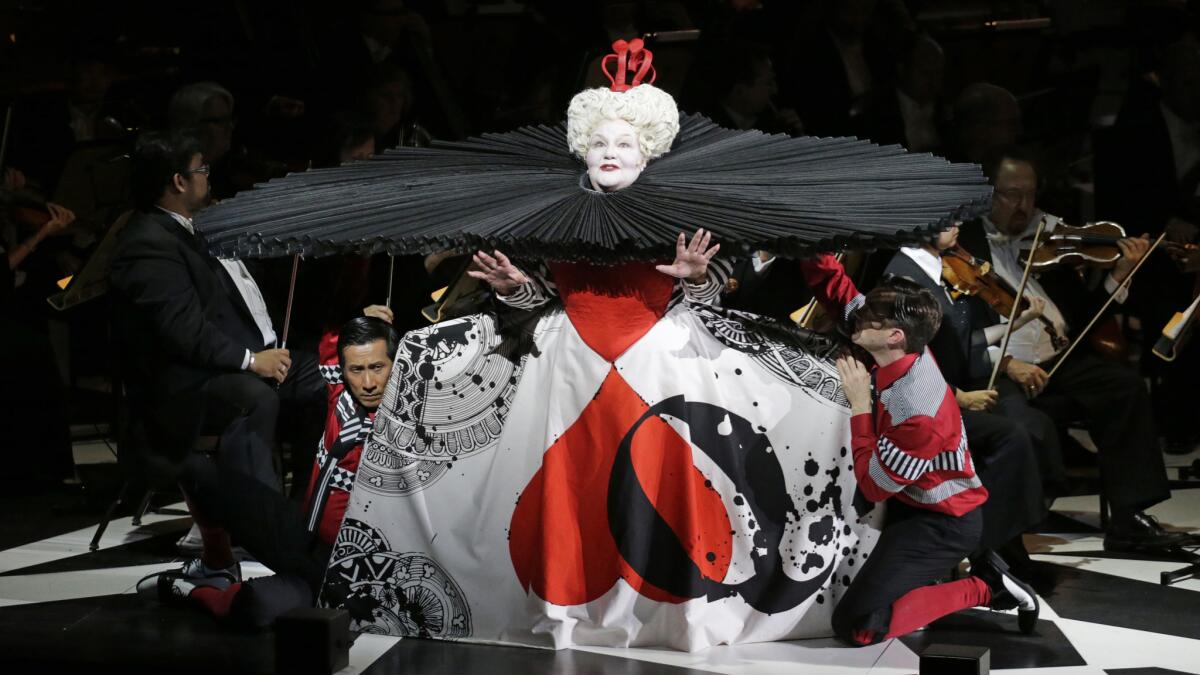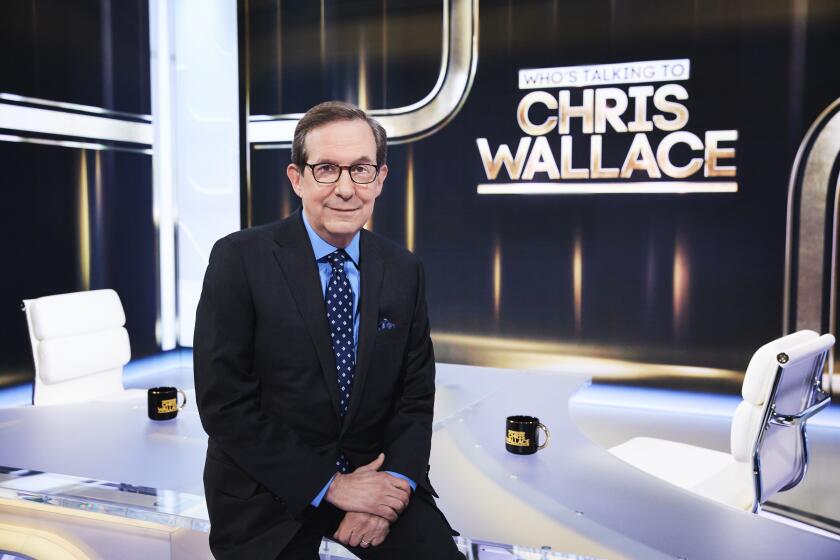Review: ‘Alice in Wonderland’ at Disney Hall proves exhilarating

Alice wants her wonderland.
Lewis Carroll’s iconic creation is such a natural for music you might have expected a surfeit of Alice operas in the 150 years since the publication of “Alice’s Adventures in Wonderland.” Yet none were notable enough in 1992 for inclusion in the first edition of the New Grove Dictionary of Opera.
That changed in 2007, when modernist Korean composer Unsuk Chin’s arresting “Alice in Wonderland” — originally meant for La La Land — had its premiere in Munich, Germany. But on Friday night, with an elaborate production and dazzling performance given by the Los Angeles Philharmonic at Walt Disney Concert Hall, Chin’s “Alice” came home, carrying enough baggage to make an airline rich.
ESSENTIAL ARTS & CULTURE NEWSLETTER >> Get great stories delivered to your inbox
Chin has had a long L.A. relationship, going back two decades with the orchestra. A dozen years ago, Los Angeles Opera’s first music director, Kent Nagano, persuaded the company to commission “Alice,” and it has been an L.A. Opera blot that it has never gotten around to performing what has become one of the most celebrated operas of the past decade.
That now is a wonderland under the bridge. The L.A. Phil production of “Alice” — directed and designed by video artist Netia Jones — was presented in collaboration with L.A. Opera, which contributed the small chorus and excellent young singers from its artist-training program.
The project itself proved a huge undertaking. Fifteen singers assumed 31 roles. Chin’s orchestra is a literal kitchen sink. The score in fact calls for, among the percussion instruments, “kitchenalia” (namely pots, pans and utensils).
Onstage for nearly two hours, Alice is asked to do crazy things with her voice, not the least reaching and often remaining within the stratosphere. Nothing in this opera is easy, and that includes the music assigned to the Los Angeles Children’s Chorus.
If all this exuberance sounds exhilarating, it was on Friday. Finnish conductor Susanna Mälkki got a dazzling array of bright colors from the L.A. Phil. As Alice, soprano Rachele Gilmore took a listener to seemingly new places; the higher her voice went, the more wondrous the wonderland.
But Chin’s “Alice” is not childish. It is a dream opera with a dark side. The libretto by David Henry Hwang functions on the level of Carrollian wordplay rather than narrative. Text here is secondary to music. We, of course, know the characters. But the White Rabbit, Mad Hatter, Cheshire Cat and Queen of Hearts are weird not in the way of surreal fantasy but rather as dreams pregnant with disturbing meaning.
Jones’ inspiration, therefore, was to base her production on illustrations by Ralph Steadman, whose work appears in Hunter S. Thompson’s “Fear and Loathing in Las Vegas.” Steadman is one of the art world’s great paranoids. Angst and ink splats are his trademark.
Disney became a vast set of black-and-white checkerboard design over the floor of the stage. Splats were everywhere onstage, on the costumes. The singers acted on asymmetrical ramps behind the orchestra and also in front of the musicians.
The wonderland, though, was best viewed on an angled overhead video screen. Steadman personified Carroll’s characters, making Walrus and Carpenter, for instance, caricatures of British politicians.
Jones captivatingly turned these into animation, done in real time during the performance.
She also extended Steadman’s influence into her costumes, but she followed her own fancy as well. Alice was a little girl. The Queen of Hearts had a hilariously over-styled 18th century look. With 100 costumes, the production had just about everything else in between, including the Mad Hatter as a businessman in bondage. She occasionally projected the live performers into the video illustrations.
The only problem was that it was much too much. Chin’s opera is so brilliantly orchestrated that the instruments alone are more than enough to steal all of an audience’s attention. Chin and Hwang assume we know Carroll well and are ready to take a leap. But the madcap physical production had the opposite effect of constantly making us wonder what was what.
In fact, installing a covering on the stage floor along with the rear ramps inevitably changed Disney’s renowned acoustics. The singers, often in remote parts of the stage, required amplification. The orchestra is experimenting with a new sound system, so that added other variables.
For the most part the balances were decent. The amplified voices were clean but nonetheless artificial. The floor may have turned the treble up slightly, but Mälkki expertly controlled orchestral sparkle.
Still, this is a difficult enough opera for a conductor to pull off even without distracting staging. For the first hour, Chin often seems to be finding her operatic footing, relying on her gift for illuminating complexity with shimmering, nearly tactile instrumental color to also supply theater.
Some of Alice’s early adventures then become experiments, and one is unforgettable. The Caterpillar is portrayed by a stunning bass clarinet solo (played by David Howard), while the bug’s advice to Alice, rather than spoken or sung, is projected as text.
The opera’s second hour becomes more playful, political and human. Chin serves up a marvelously screwy version of “Twinkle, Twinkle, Little Star.” The Queen of Hearts seems to have stepped out of a grand opera in an alternative universe, and soprano Jane Henschel was a delight.
So too were Dietrich Henschel’s Mad Hatter, Andrew Watts’ White Rabbit and Marie Arnet’s Cheshire Cat. They are, though, just the start of a long list deserving credits.
Presenters from around the world descended on Disney for the two weekend performances. More presumably will head to London when the BBC Symphony mounts Jones’ full production at the Barbican Centre. But anyone looking to save money and headaches might consider a concert performance with video, which is already a full wonderland for eyes, ears and psyche.
Twitter: @markswed
More to Read
The biggest entertainment stories
Get our big stories about Hollywood, film, television, music, arts, culture and more right in your inbox as soon as they publish.
You may occasionally receive promotional content from the Los Angeles Times.











